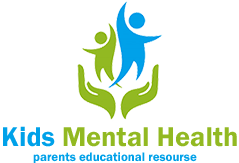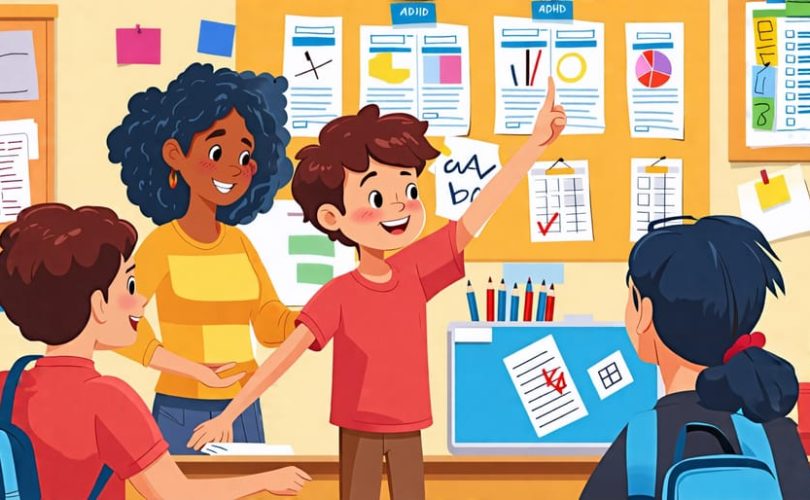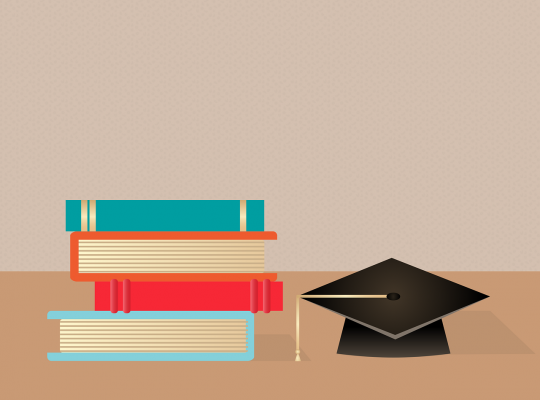Develop a positive, nurturing relationship with the student. Take time to understand their unique strengths, challenges and motivations. Collaborate closely with parents and school staff to ensure consistent support across settings.
Implement effective ADHD classroom strategies like providing clear structure, breaking tasks into smaller steps, offering frequent feedback, and allowing movement breaks. Experiment to find what works best for each student.
Foster the student’s self-esteem and sense of accomplishment. Praise effort and progress, not just outcomes. Help them identify and develop their talents. Encourage them to advocate for their needs.
Educate yourself about ADHD and evidence-based interventions. Seek out professional development, consult with experts, and stay current on the latest research to continually improve your ability to effectively support students with ADHD.


Partnering with Teachers and the School
Individualized Education Programs (IEPs) and 504 Plans
When a student with ADHD struggles in school, it’s important to consider individualized education programs (IEPs) or 504 plans. These legal documents outline specific accommodations and support services tailored to the student’s unique needs. IEPs are designed for students who require special education services, while 504 plans provide accommodations for students with disabilities who do not require specialized instruction.
Both IEPs and 504 plans can offer a wide range of accommodations, such as extra time on tests, preferential seating, modified assignments, and assistive technology. These accommodations aim to level the playing field, allowing students with ADHD to demonstrate their knowledge and abilities without being hindered by their challenges.
To set up an IEP or 504 plan, parents should first reach out to their child’s school and request an evaluation. This process typically involves a team of professionals, including teachers, school psychologists, and special education experts, who assess the student’s strengths and needs. The team then works with the parents to develop a comprehensive plan that outlines specific goals, accommodations, and support services.
It’s essential for parents to advocate for their child throughout this process, sharing their insights and concerns. Regular communication with the school team is crucial to ensure the plan is implemented effectively and adjusted as needed. By collaborating closely with the school and staying involved in their child’s education, parents can help create a supportive environment that fosters their child’s academic, social, and emotional growth.
Classroom Accommodations and Strategies
Supporting students with ADHD in the classroom often requires a collaborative effort between teachers, parents, and healthcare professionals. By implementing accommodations and strategies tailored to the individual student’s needs, educators can create an environment that fosters academic success and overall well-being. Visual aids are one effective tool for helping students with ADHD stay focused and organized. These can include color-coded schedules, picture checklists for multi-step tasks, and graphic organizers for writing assignments. Providing visual reminders of classroom rules and expectations can also help students stay on track.
Breaking tasks into smaller, manageable steps is another key strategy for supporting students with ADHD. This approach can make assignments feel less overwhelming and help students maintain focus. Teachers can provide clear, written instructions for each step and check in with the student regularly to ensure they are progressing. Offering frequent breaks and opportunities for movement can also be beneficial. Students with ADHD may struggle to sit still for extended periods, so incorporating short brain breaks, stretching exercises, or classroom jobs that involve movement can help them regain focus and reduce restlessness.
Providing a quiet, distraction-free workspace can be particularly helpful for students who are easily distracted by visual or auditory stimuli. This may involve seating the student away from windows, doors, or high-traffic areas in the classroom. Noise-canceling headphones or earplugs can also be useful tools for minimizing distractions during independent work time. In addition to these accommodations, positive reinforcement and praise can go a long way in building a student’s confidence and motivation. Acknowledging small successes, effort, and improvement can help students with ADHD stay engaged and feel valued in the classroom.
Teachers can also work with parents and healthcare professionals to develop an Individualized Education Plan (IEP) or 504 Plan that outlines specific accommodations and supports for the student. These plans ensure that the student’s needs are being met consistently across all classes and provide a framework for ongoing communication and collaboration between the school and home. By implementing a combination of accommodations, strategies, and positive support, educators can create a classroom environment that enables students with ADHD to thrive academically, socially, and emotionally.

Building Executive Function Skills
Executive functions are a set of cognitive skills that help us plan, organize, prioritize, and regulate our behavior. For children with ADHD, these skills can be particularly challenging, leading to difficulties in learning and academic performance. However, with the right strategies and support, children with ADHD can improve their executive function skills and thrive in school.
One key aspect of executive function is organization. Children with ADHD may struggle with keeping track of assignments, materials, and deadlines. To help them stay organized, parents and teachers can work together to create visual schedules, checklists, and color-coded systems. For example, using a planner or calendar to break down large projects into smaller, manageable tasks can make them feel less overwhelming. Establishing a designated study space at home and keeping school supplies organized can also help minimize distractions and improve focus.
Time management is another important executive function skill. Children with ADHD may have trouble estimating how long tasks will take or get easily sidetracked. Using timers, visual cues, and frequent check-ins can help them stay on track. Breaking tasks into smaller chunks and taking short breaks can also prevent frustration and burnout. Encouraging children to prioritize tasks based on importance and urgency can help them develop better planning skills over time.
Self-regulation is the ability to manage one’s emotions, behavior, and attention in different situations. For children with ADHD, this can be particularly challenging, especially in the face of stress or frustration. Teaching deep breathing exercises, mindfulness techniques, and positive self-talk can help children learn to manage their emotions and stay focused. Role-playing different scenarios and discussing appropriate responses can also help children practice self-regulation skills in a safe and supportive environment.
Incorporating movement and physical activity throughout the day can also help improve executive function skills. Exercise has been shown to increase brain function and reduce ADHD symptoms. Encourage children to take movement breaks, participate in sports or physical activities they enjoy, and use fidget toys or stress balls when needed.
Remember, building executive function skills takes time and practice. Celebrate small victories and progress along the way, and be patient and supportive as children learn and grow. With the right tools and strategies, children with ADHD can develop the skills they need to succeed in school and beyond.
Nurturing Self-Esteem and Resilience
Children with ADHD often struggle with self-esteem and emotional regulation due to the challenges they face in school, social situations, and daily life. The constant struggle to meet expectations and fit in can leave them feeling inadequate, frustrated, and even hopeless. As a parent, teacher, or healthcare professional, it’s crucial to recognize the impact of ADHD on a child’s self-worth and take proactive steps to foster a positive self-image.
One of the most important things you can do is to celebrate the child’s strengths and unique qualities. Children with ADHD often have incredible creativity, enthusiasm, and problem-solving skills that can be overshadowed by their struggles. Take time to acknowledge and praise their talents, interests, and accomplishments, no matter how small they may seem. This helps them develop a sense of pride and confidence in their abilities.
Another key aspect of nurturing self-esteem is to reframe challenges as opportunities for growth. Instead of focusing on failures or setbacks, emphasize the importance of perseverance, learning from mistakes, and trying new strategies. Encourage the child to set realistic goals and break them down into manageable steps, celebrating each milestone along the way.
It’s also essential to create a supportive and understanding environment at home and school. Educate family members, teachers, and peers about ADHD and the challenges it presents. Encourage open communication and provide a safe space for the child to express their feelings and concerns. Model healthy coping strategies, such as deep breathing, mindfulness, and positive self-talk, to help them manage stress and regulate their emotions.
Finally, building resilience is crucial for children with ADHD. Help them develop a growth mindset by emphasizing the value of effort, learning, and improvement over perfection. Encourage them to take on new challenges, learn from failures, and bounce back from setbacks. Provide them with opportunities to develop their interests, form positive relationships, and contribute to their community, as these experiences can boost their self-esteem and sense of purpose.
By nurturing self-esteem and resilience, we can empower children with ADHD to embrace their unique strengths, overcome challenges, and thrive in all aspects of their lives.

When to Seek Additional Support
While many children with ADHD thrive with the right support at home and school, there are times when additional help may be needed. Signs that a child could benefit from extra support include:
• Consistently falling behind academically despite accommodations and interventions at school
• Struggling to form and maintain friendships
• Exhibiting persistent disruptive or impulsive behaviors that impact daily functioning
• Experiencing frequent emotional outbursts or difficulty regulating emotions
• Showing signs of anxiety, depression, or low self-esteem
If you notice these or other concerning patterns, it’s important to reach out for professional support options. A good first step is to talk with your child’s pediatrician or a mental health professional who specializes in ADHD. They can help assess your child’s specific needs and recommend appropriate interventions.
One option is tutoring or educational therapy to address academic challenges and build study skills. A tutor who understands ADHD can work with your child’s unique learning style and help them stay on track in school.
Psychotherapy, such as cognitive-behavioral therapy (CBT), can be tremendously beneficial for children with ADHD. A therapist can help your child learn coping strategies, improve social skills, and build self-esteem. Family therapy may also help address relationship strains and teach positive parenting techniques.
In some cases, medication may be recommended as part of a comprehensive treatment plan. Stimulant medications like Ritalin or Adderall can help improve focus and reduce impulsivity. Non-stimulant options are also available. Your child’s doctor can discuss the potential benefits and side effects of medication.
Remember, every child’s needs are unique. What works for one student with ADHD may not be the best fit for another. Trust your instincts, and don’t hesitate to advocate for the support your child needs. With the right combination of interventions and a strong network of understanding adults, your child can thrive and reach their full potential.







